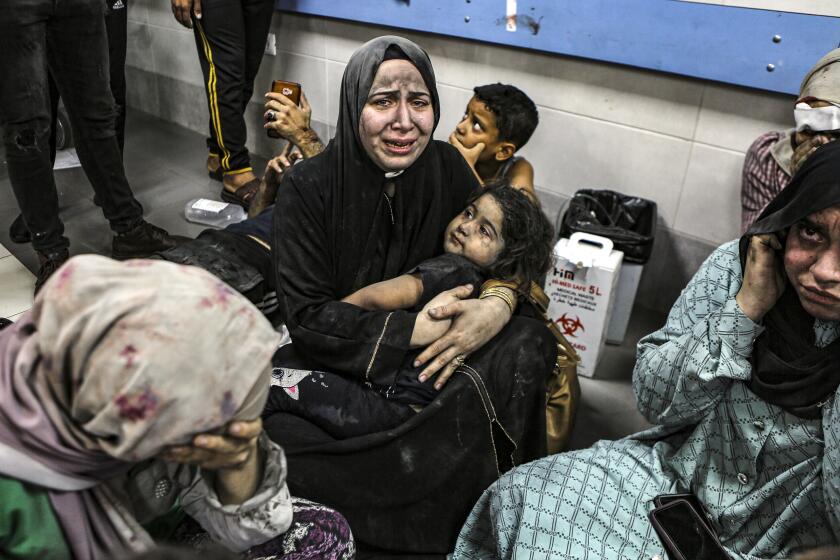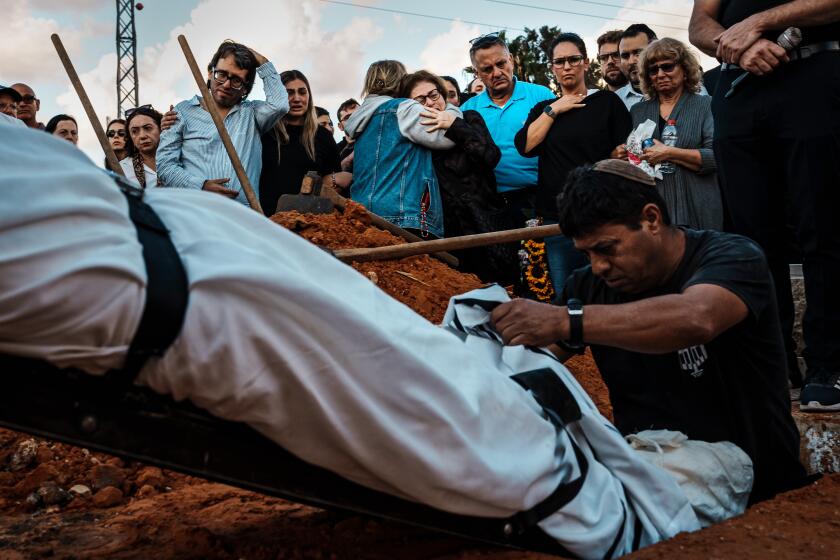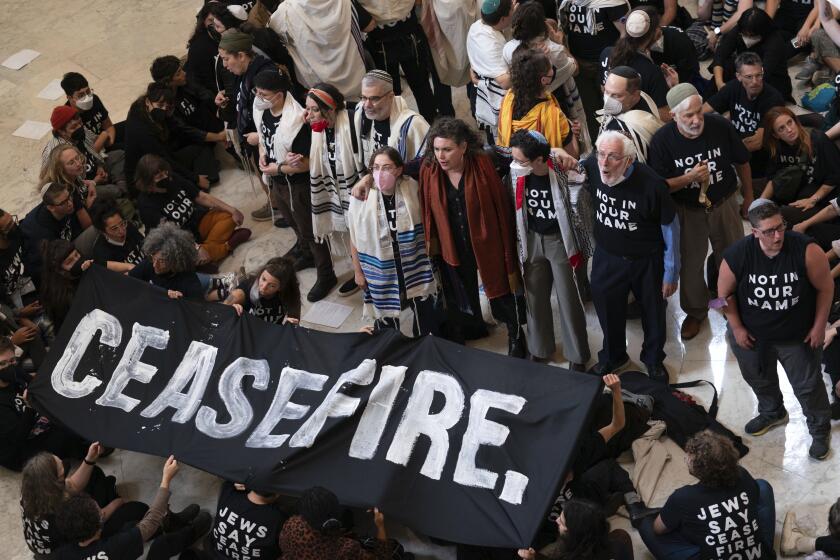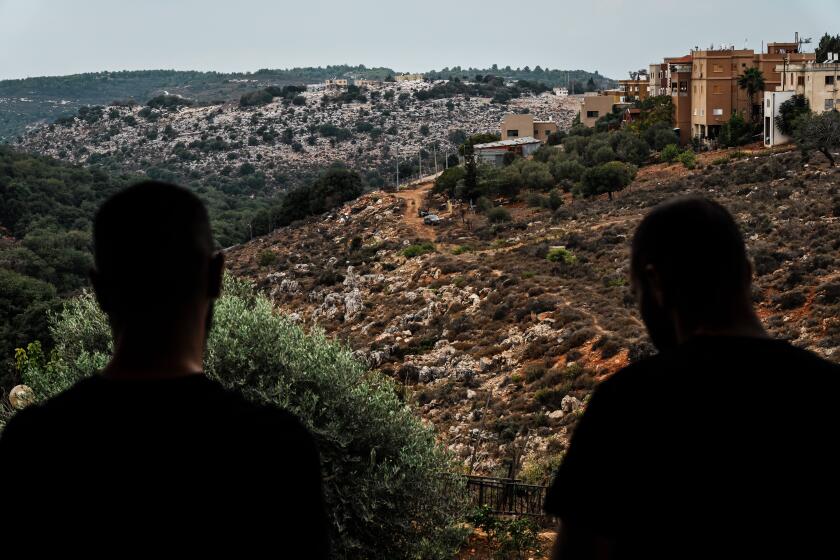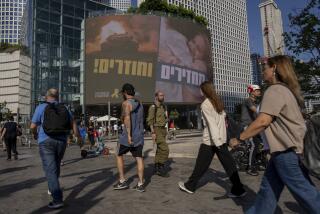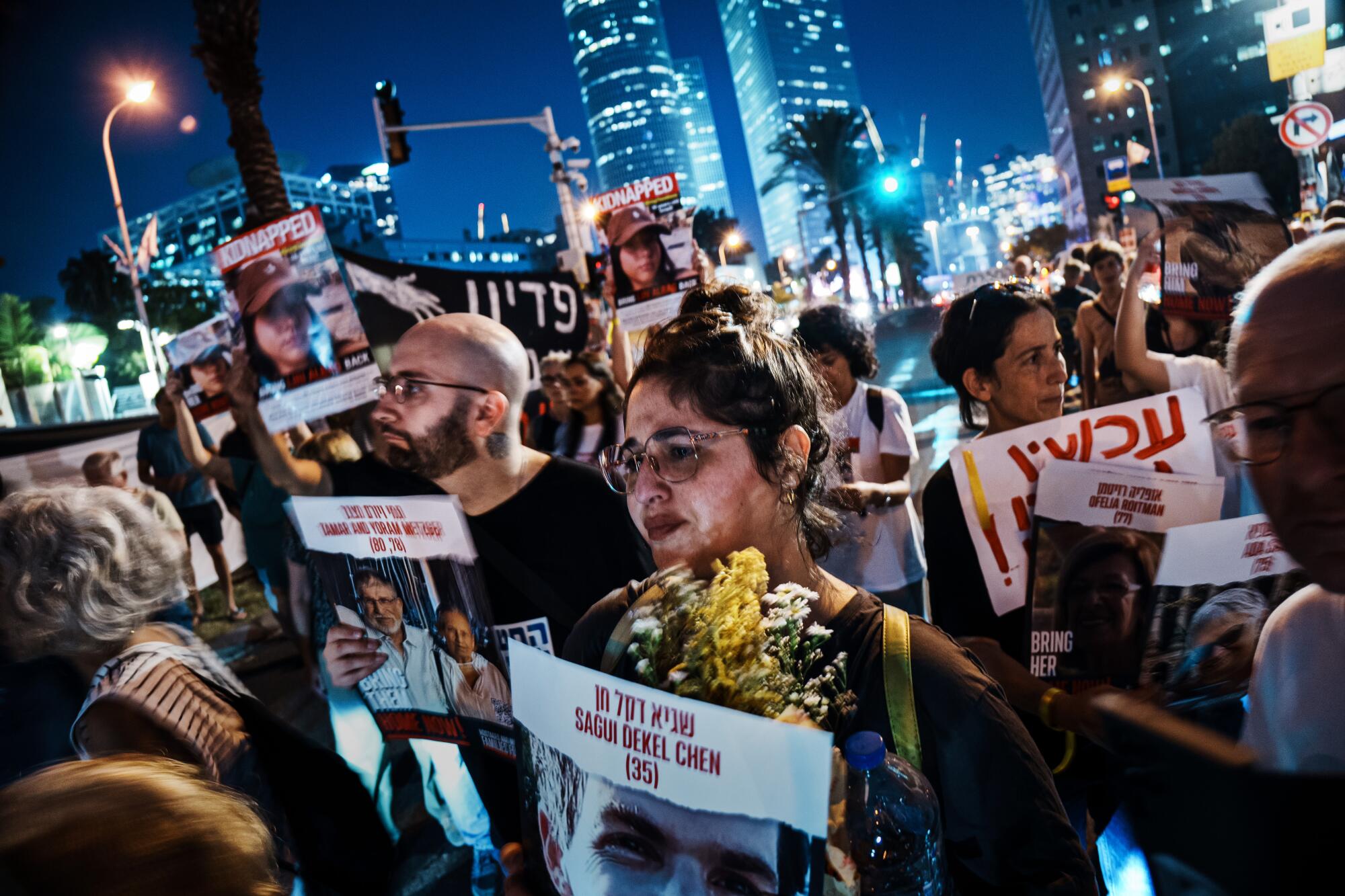
TEL AVIV — These days, when Israelis speak of loved ones who are missing and believed held by the militant group Hamas, they sometimes make a small, heartbreaking slip of the tongue.
“She was so brave,” they might say. Or: “He really was a very kind person.”
Then, with a quick draw of breath, they catch themselves: She is. He is.
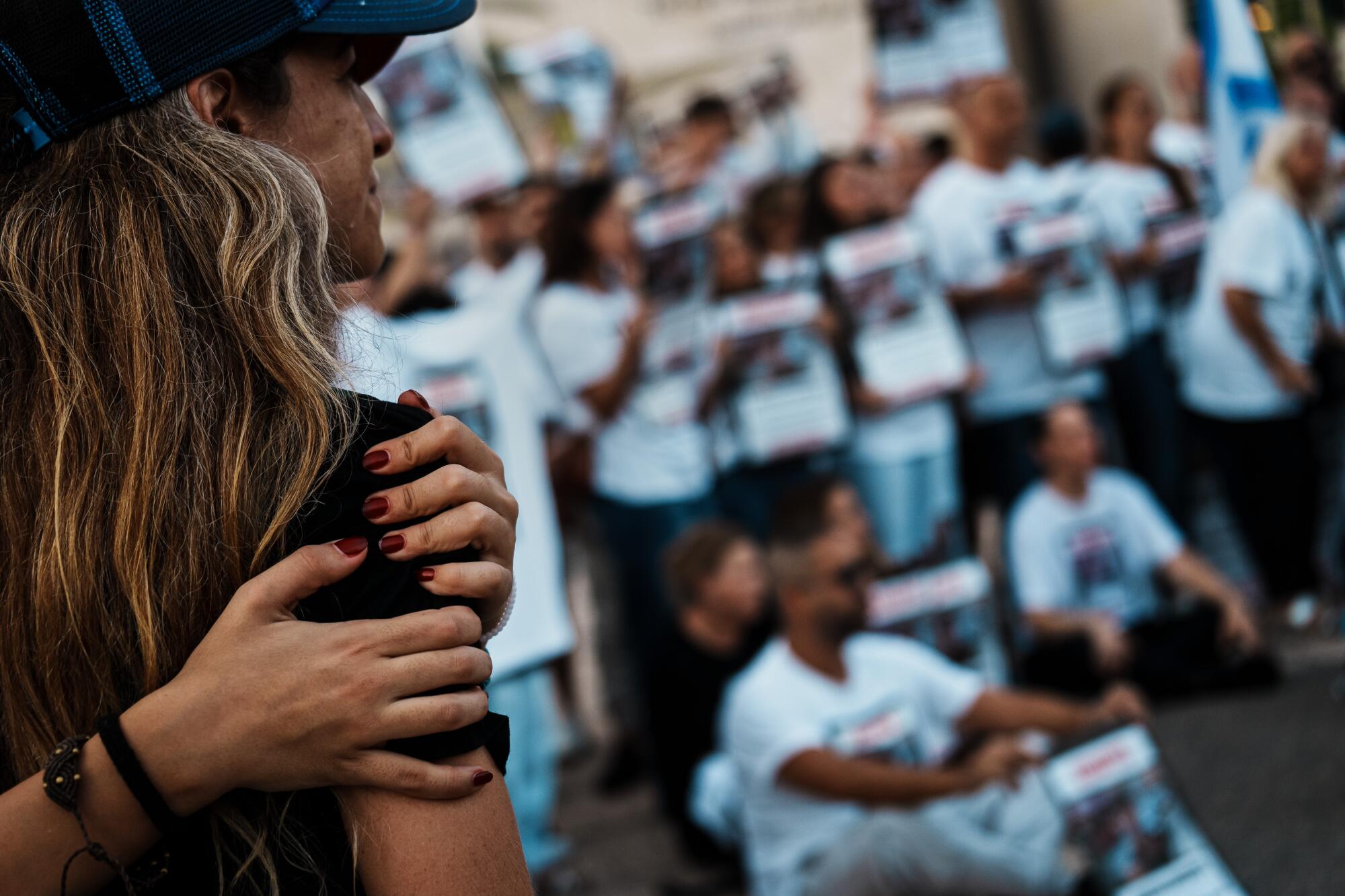
Because using the present tense connotes the belief, or at least the hope, that the missing are still among the living.
For family members and close friends of the more than 220 people seized in southern Israel during a deadly onslaught by Palestinian militants on Oct. 7, this has been a time of near-hallucinatory grief — and wrenching uncertainty.
Many families, if not most, do not know whether missing loved ones are dead or alive inside the Gaza Strip, the densely populated coastal enclave that is now being pummeled by Israeli bombardment, starved of food and electricity, and is under imminent threat of an Israeli ground invasion.
Those taken include grandmothers and infants, entire families together, young children separated from mothers in the chaos, teenage army conscripts and schoolchildren, foreign citizens and young people who were dancing in the desert: so varied a group as to defy categorization, other than by their common presence near the Gaza fence on that fateful Saturday morning.
Israel and the Palestinian militant group Hamas appear set to go head-to-head on the ground in Gaza. What’s each side’s endgame?
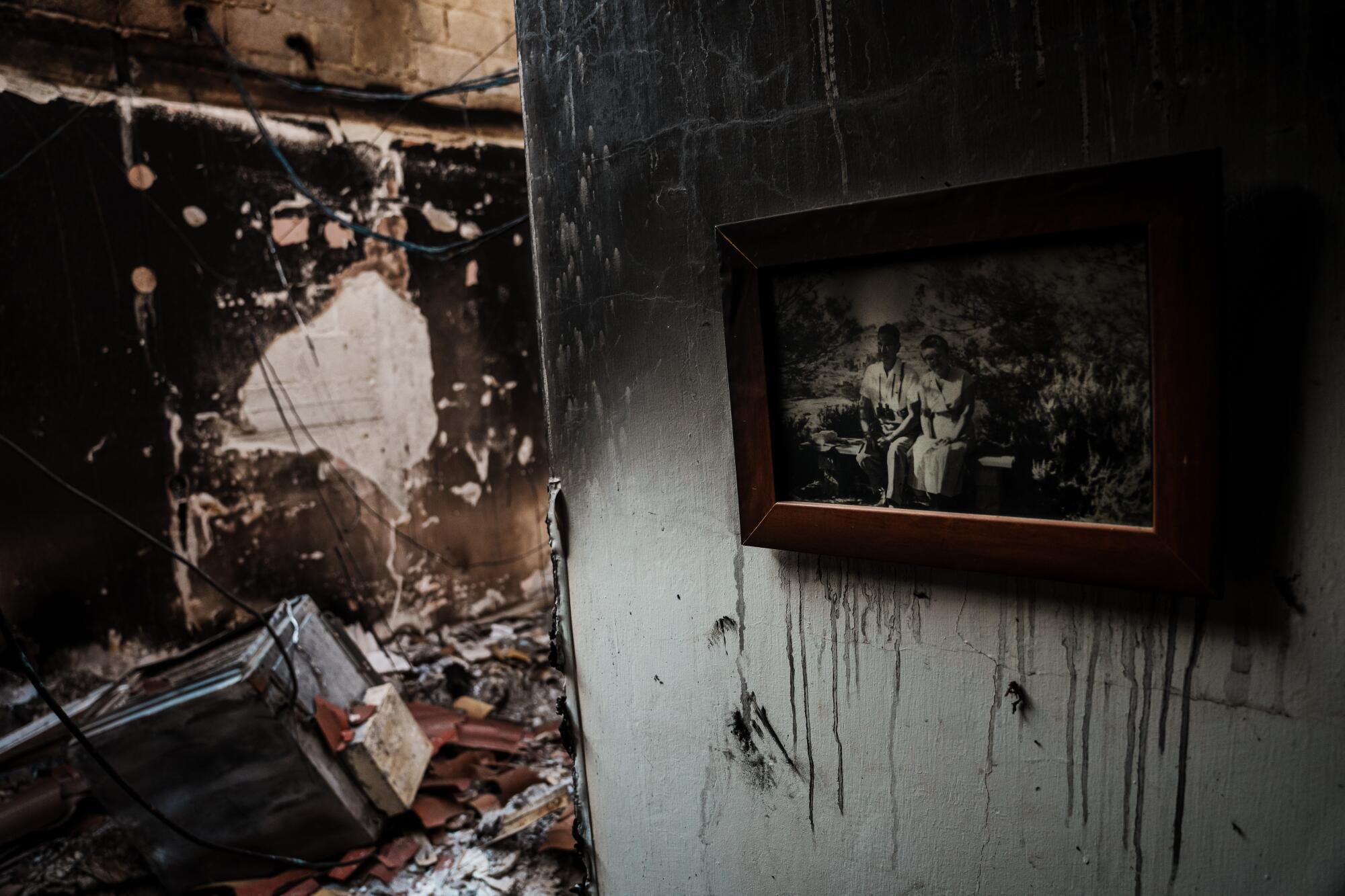
So gruesome was the Hamas-led rampage of Oct. 7, with the bodies of many victims mutilated or burned beyond recognition, that forensic specialists are still identifying the dead, and funerals occur daily across the country. That has accounted for slight shifts over time in the numbers of those listed as missing and presumed to have been abducted.
The count has also fluctuated as some foreigners who were visiting Israel were added to the tally. As of Tuesday, the hostage total was 222.
In some cases, there is video proof, derived in part from surveillance footage but often from the bodycams of the Hamas attackers themselves, of captives being snatched up. Or their smartphones pinged a signal from inside the Gaza Strip before falling silent.
Or surviving eyewitnesses — those who were not among some 1,400 people slaughtered that day — told rescuers they had seen them dragged away, loaded into trucks, onto motorcycles or even into golf carts, and spirited across the Gaza frontier.
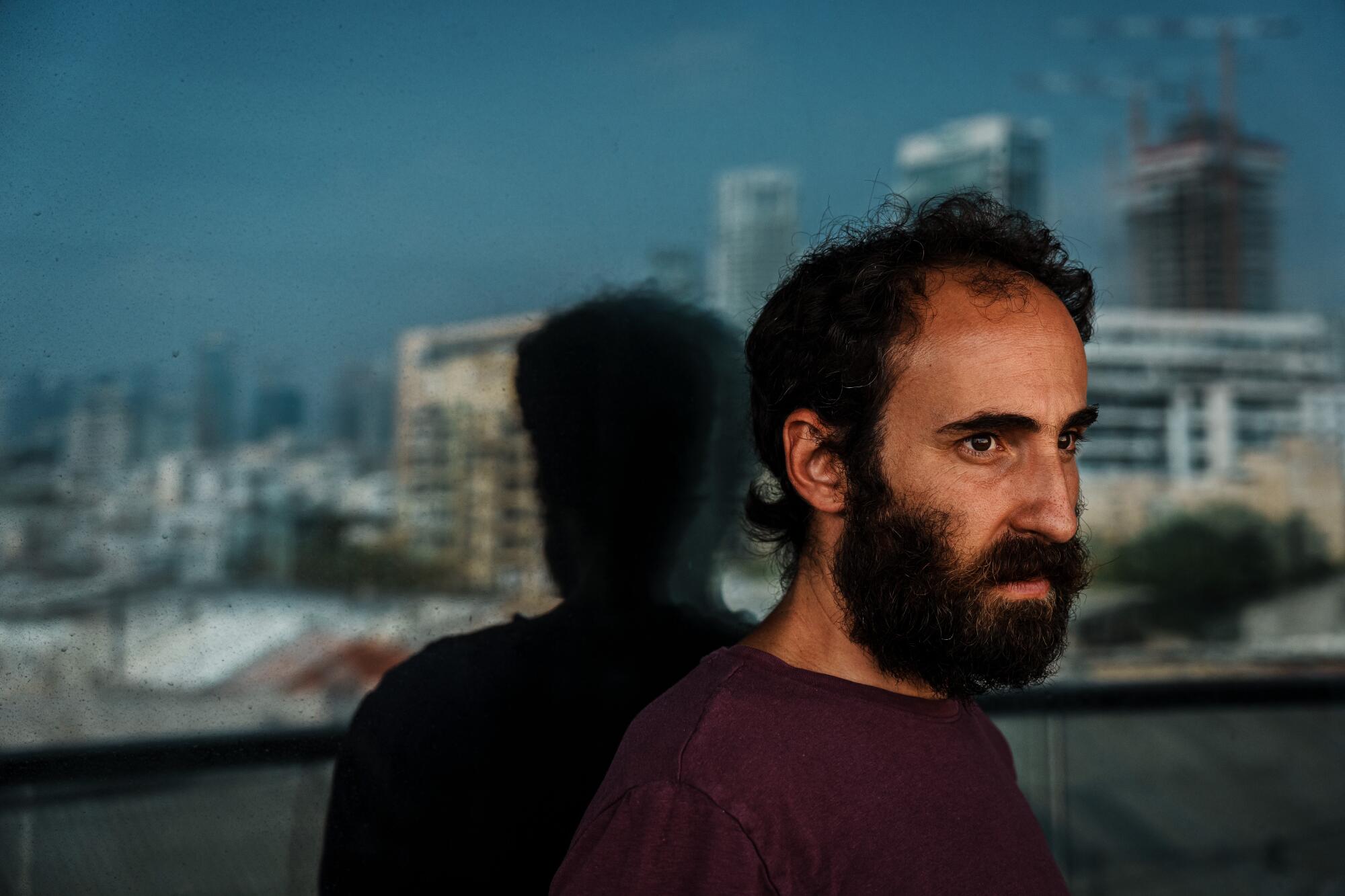
Those captives, the ones who unwittingly left a trail of digital breadcrumbs or were fleetingly glimpsed by a terrified onlooker, are the ones whose families have some tangible proof of life, at least at that particular point in time, to cling to — which is, of course, its own kind of agonizing purgatory.
Scores of others, though, simply vanished.
“I am with you,” Yonatan Zeigen, a Tel Aviv father of three, texted his 74-year-old widowed mother, Vivian Silver, as the attack unfolded in her southern kibbutz. Over a period of hours, she had told him that the assailants were inside the community, that they had drawn close to her house. That she was hiding.
“I feel you,” she replied.
Then, nothing.
: :
For Israelis, a hostage event of this scope and nature is difficult even to put into historical perspective.
Since the advent of statehood 75 years ago, the closest analogue involving mass captivity might be Entebbe — shorthand for the 1976 hijacking that ultimately led to 103 captives being rescued in Uganda by an Israeli commando squad.
As so often happens here, time echoes in peculiar ways: The only Israeli soldier killed in the daring Entebbe raid was 30-year-old Yonatan Netanyahu, elder brother of Israel’s embattled prime minister, Benjamin Netanyahu.
Few, though, expect the current crisis to assume a place comparable to Entebbe in the national mythology: tragedy turned to triumph. It’s more a question, many fear, of exactly how terrible the outcome will be.
In recent decades, hostage episodes have been far smaller-scale affairs: politically fraught, personally harrowing, but also contributing to a long-accepted political and social contract: that Israel will not abandon its own.
Israel-Hamas war: In Israel, a quest to identify unrecognizable bodies. In Gaza, bodies are piled and some stored in ice cream trucks as power fails.
In 2011, the Israeli government traded more than 1,000 Palestinian prisoners for captured Israeli soldier Gilad Shalit, one of several such lopsided swaps over the years.
Almost three weeks into the current crisis there have been brief moments of hope amid the gloom: the releases, days apart, of two pairs of hostages.
Last week saw the freeing of U.S. citizens Judith and Natalie Raanan, a mother and daughter, 59 and 17, from suburban Chicago. They were visiting relatives when the Hamas attack occurred.
On Monday night, two Israeli women, Nurit Cooper, 79, and Yocheved Lifshitz, 85, were handed over to the Red Cross by Hamas.
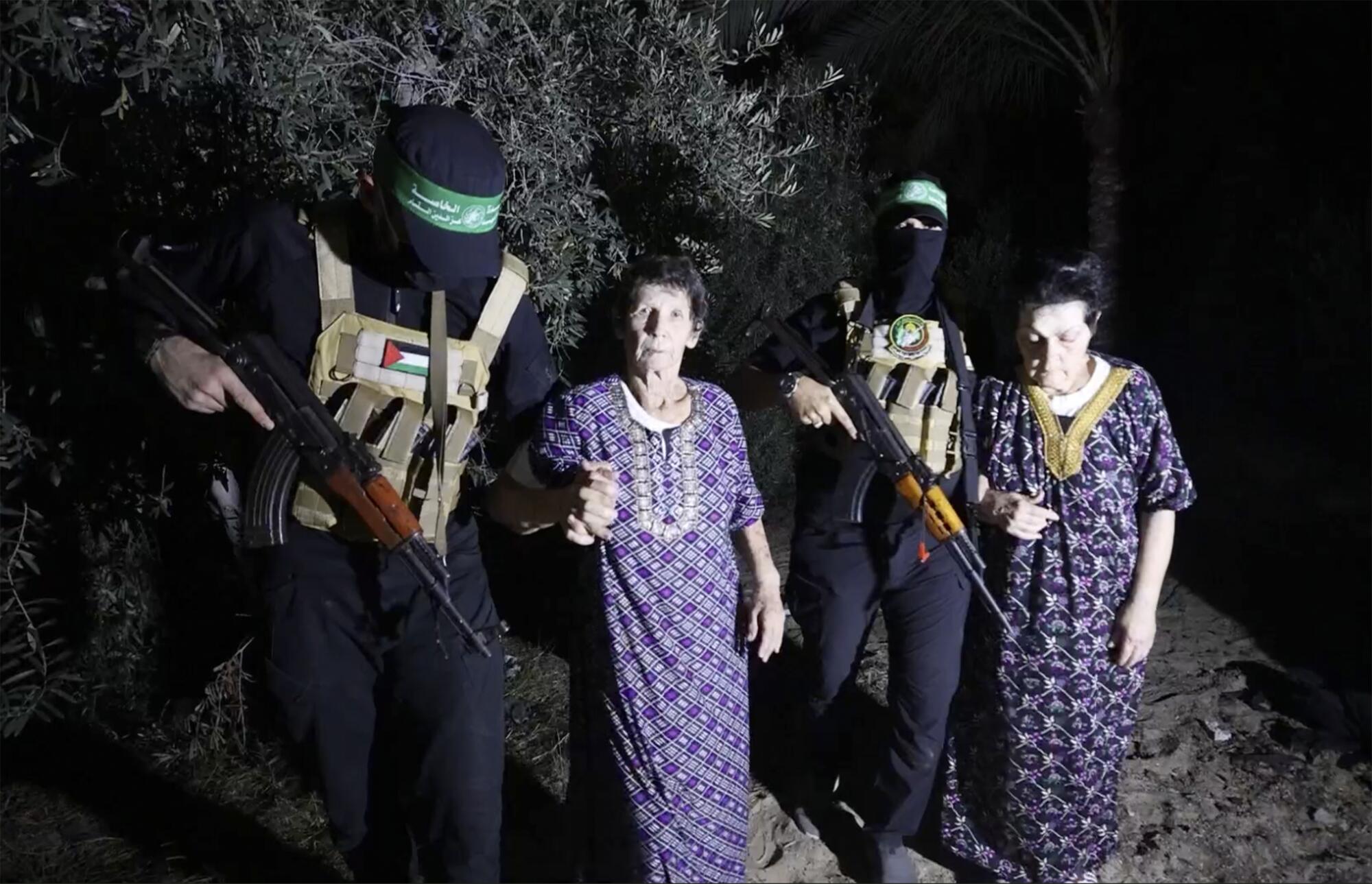
Lifshitz told reporters at a Tel Aviv hospital on Tuesday of being spirited into Gaza through a dank “spiderweb” of tunnels after the militants’ assault on her kibbutz, which left nearly half of its 400 inhabitants dead or missing.
“My memory keeps replaying those pictures,” she said of the hours-long attack.
The immense Hamas tunnel network, whose existence has long been known to Israeli intelligence, haunts the dreams of the hostages’ families, who voice enormous anxiety over the prospect of an Israeli ground invasion of Gaza.
They fear that their captive relatives would have little chance of surviving bloody urban combat — some of it subterranean — that military experts say an Israeli ground offensive would entail.
The U.S. government has advised Israel to delay an invasion to allow more time to negotiate the release of hostages. But Israeli media reports have suggested that Netanyahu’s government is not prepared to prioritize the hostages’ safety over its aim of eradicating Hamas.
The Israeli newspaper Haaretz, quoting a Mossad spy agency official who has worked on past hostage deals, cited prospects for a large-scale release as a fading hope the longer the captives are held.
“If we wait until after the war,” said Mossad veteran David Meidan, “many of those we’re talking about will not be alive.”
: :
In spite of proximity to Gaza, and the rockets regularly fired by Palestinian militants from inside the enclave, Israeli residents of a string of southern communities described a life they regarded as not only peaceful but safe, even idyllic.
The Israeli military was strong, and the border was secure, with electronic eyes everywhere. Or so they believed.
One particularly cruel irony is that the targeted villages were havens for Israelis of a leftist bent, who believed — some passionately — that coexistence with the Palestinians was possible, that Israel’s occupation of the West Bank was wrong, that the near-hermetic sealing off of Gaza and its more than 2 million Palestinian inhabitants risked an eventual explosion of violence.
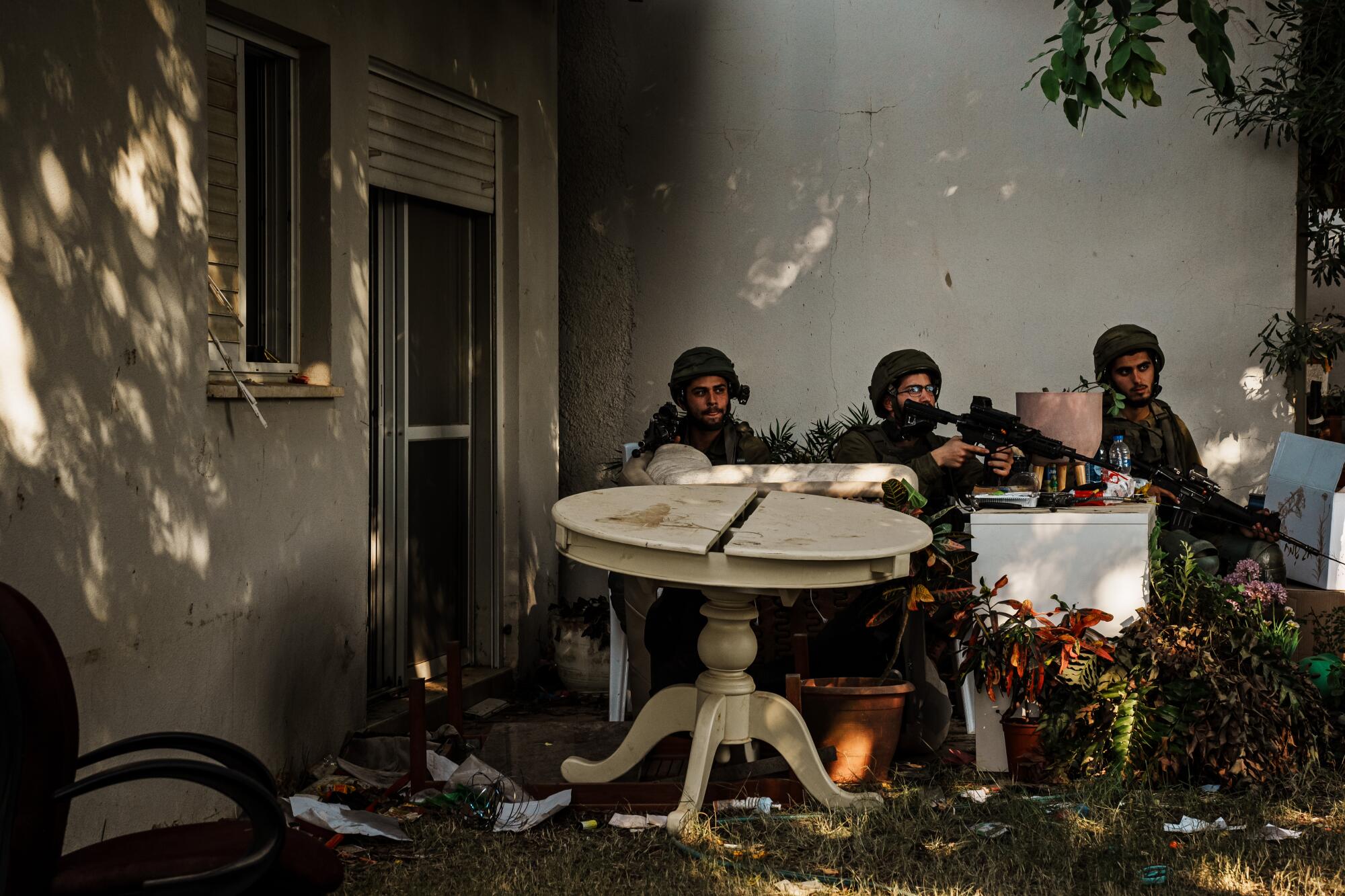
Zeigen said his mother, a longtime peace activist,would hate the idea of Palestinian civilians being put in harm’s way.
Since the start of the war, more than 5,700 Palestinians have been killed inside the enclave, according to the Palestinian Ministry of Health, which in Gaza is controlled by Hamas. Israeli bombing has leveled entire districts, hundreds of thousands are displaced, and aid groups call it the territory’s gravest humanitarian crisis in decades.
“She would be devastated over both sides suffering so much loss and destruction,” Zeigen said of his mother.
‘Our human ask is that people give a damn when we die,’ said one rabbi. Amid the Israel-Hamas war, many U.S. Jews feel betrayed by people they thought were allies.
While many Israelis have been infuriated by Netanyahu’s refusal to engage with hostages’ families as the crisis drags on, relatives said they felt buoyed by meetings with President Biden and, this week, with Israel’s President Isaac Herzog, who holds a mainly symbolic role in the country’s leadership.
“We felt that everyone, all the country, is standing with us,” said Yael Engel Lichi, whose 18-year-old nephew, Ofir Engel, was visiting his girlfriend at one of the devastated kibbutzim when the attackers struck. He was last seen being loaded into a black vehicle by militants.
His aunt, who lives outside Jerusalem, likened the hostage families’ despair to a widening circle, like ripples spreading outward in a pond.
“Since this happened, all his friends, and all their friends, are coming every day to be with us,” she said. “There is almost no one who doesn’t experience this somehow.”
: :
Israel can sometimes look like a chaotic place, but there are occasions when its citizenry organizes itself with astonishing rapidity. That has proved to be the case during the hostage crisis.
Grassroots efforts swiftly sprang up to coordinate communication between the families of the missing and Israeli officialdom. Crowds converge for candlelight vigils. Demonstrators gather daily outside the Kirya, the military headquarters in Tel Aviv, in a poignant and potent reminder that the captives should not be forgotten.

Israel’s vaunted startup culture swiftly took on a vital role. Within the first 24 hours, a pair of Tel Aviv entrepreneurs, both veterans of the country’s security services, mobilized a high-tech “war room” of civilian volunteers, the bulk of them twentysomethings with formidable cyberskills honed in elite military intelligence units.
In a sleek Tel Aviv suburb known as Israel’s Silicon Valley, clusters of young men and women hunch over laptops, using facial recognition tools and geolocation methods to comb through thousands of images from Gaza and the targeted Israeli communities, continuously scraping social media platforms for digital clues to captives’ whereabouts.
On Israel’s border with Lebanon, residents are worried that groups like Hezbollah will join a war that eventually spirals into a regionwide conflict.
“At the very beginning of this, I’d be home watching television with my mother, both of us crying,” said Ido Brosh, a 24-year-old volunteer who until eight months ago served in an army cyberunit. “But this is so much better, to use my skills to help.”
Old traditions have their place as well. As the Jewish Sabbath fell on Friday, there was a somber gathering in the courtyard of the futuristic-looking Tel Aviv art museum, in the shadow of the Kirya. A long table was laid with colorful crockery as if for a festive Sabbath meal — and lined with more than 200 empty chairs to symbolize the missing.
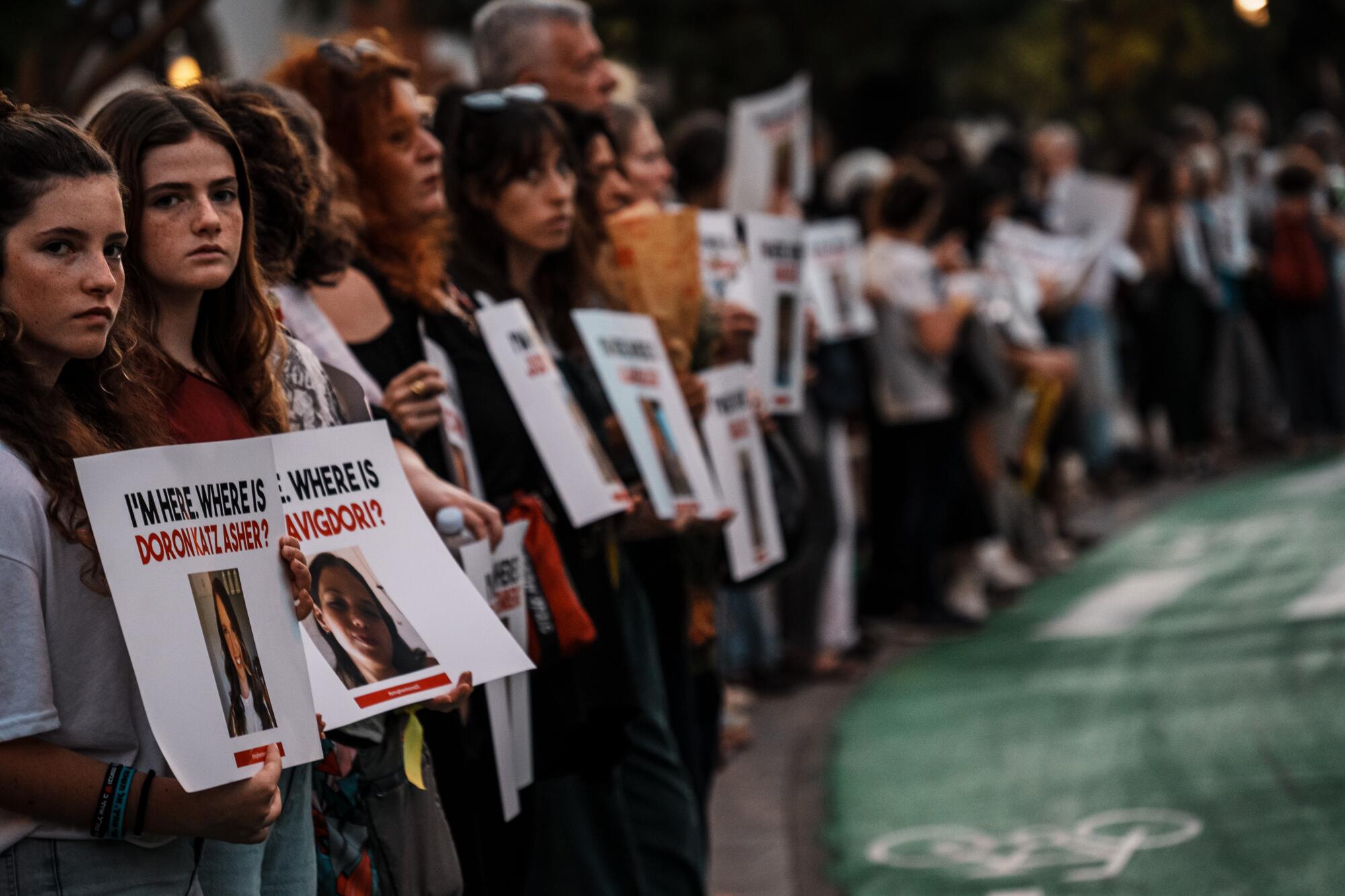
At a nearby downtown square in Tel Aviv, people come every evening to light candles crowding the circular rim of a burbling fountain, or to lay flowers in tribute to the missing. As dusk falls, many settle into chairs, chatting quietly with one another or sitting in silence.
“I feel as if this is a way to be with them, for us all to be together,” said Noam Mishali, a 31-year-old veterinary student whose black-and-white dog was curled up at her feet. “Because there is really nothing more to do but hope.”
More to Read
Sign up for Essential California
The most important California stories and recommendations in your inbox every morning.
You may occasionally receive promotional content from the Los Angeles Times.
